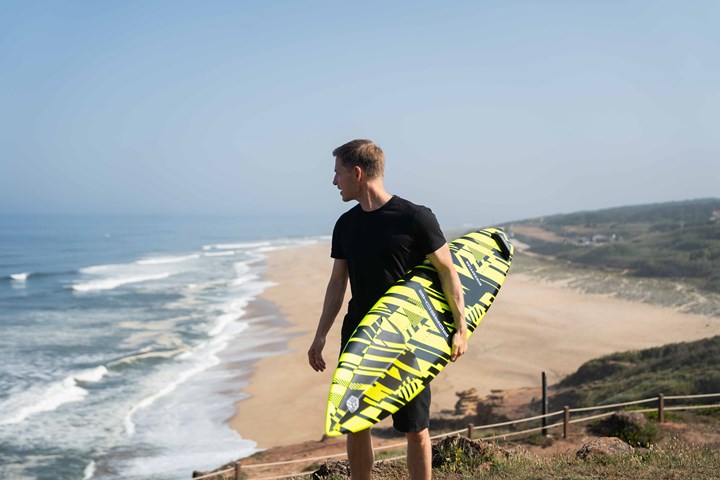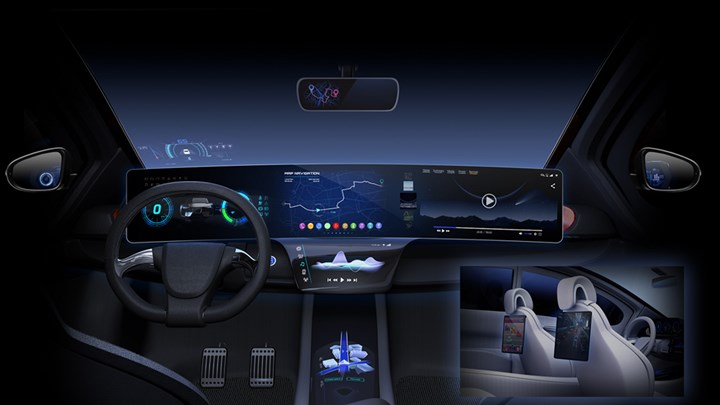on software-defined vehicles, developing batteries, Porsche surfboard, Mercedes hybrid & more
Just what is a “software-defined” vehicle. . .Porsche helps develop a surfboard. . .the challenge of developing batteries. . .electric motorcycle company models itself after Tesla. . .Mercedes brings F1 hybrid tech to a consumer car. . .advanced tech for interiors (and beyond, to the cloud). . .a Bugatti building. . .
What Does “Software-Defined Vehicle” Mean?

That alert about an emergency vehicle is the result of an over-the-air (OTA) update that Stellantis provided to vehicles in the U.S. with the appropriate Uconnect system—vehicles starting with MY 2018. A new capability that is brought to the vehicles. (Image: Stellantis)
You have a 2018 Ram 1500. You opted for the Uconnect infotainment system. Now you look at that 8.4-inch touchscreen and wonder why it is so, well, tiny.
Still, you think the Uconnect connected vehicle platform is good.
Now it is better.
No, not as in “the 2023 Ram 1500 Uconnect system is better than the 2018 system” (well, it is, but. . .).
Rather, that Ram 1500 you have now has an Emergency Vehicle Alert System (EVAS) feature.
How?
Via an over-the-air (OTA) update.
Now New
Suddenly, your pickup has tech whereby if there is an emergency vehicle in action in your vicinity, and if said emergency vehicle is connected to the HAAS Alert Safety Cloud, then you are notified via the Uconnect system (and don’t have to wonder, “Did I hear a siren? Is it coming toward me or away from me? Was it part of that song on the radio. . . ?”).
There was something that you’re 2018 Ram didn’t do. Now there is something that it can do. (As can all other Uconnect-equipped vehicles in the U.S. and Canada.)
That is the essence of the “software defined vehicle,” explains Yves Bonnefont, Stellantis Chief Software Officer.
“A software-defined vehicle,” he explains, “is one whose features and functionality are mainly defined by software, which means they can evolve over time while the hardware remains constant.”
Like Your Phone
Bonnefont uses the smartphone as an example. Over time you load it up with apps that provide it with additional functionality. You can do things with it—from finding a date to finding a constellation—that you weren’t able to on day one.
Whereas vehicles have historically had the same capability on day one to the day you trade it in (assuming, of course, that you’ve not made aftermarket mods), Bonnefont says, “The overall idea is the vehicle platform becomes an open platform which evolves during the lifecycle of the vehicle, which obviously was not the case in our industry for many, many years.”
While it is somewhat easy to think about a vehicle getting OTA updates for things like new entertainment apps, capabilities such as EVAS are arguably something at a higher level. Bonnefont points out that it was something that they weren’t even thinking about when the 2018 models were launched. (It actually has its roots in the Stellantis Star*Up employee innovation program.)
The hardware in the 2018 model didn’t change. But the software did.
But in the hardware sphere Stellantis is working on a new architecture called “STLA Brain.”
Leveraging Capabilities
Bonnefont says STLA Brain, which is scheduled to launch next year, has a “service-oriented architecture.” Today there is what he says is a “signal-based architecture.” The signals are predefined and unchanging. The service-oriented approach is one where the messages are sent out on a network and can be accessed by on-board electronic units as needed.
He uses a camera used in a vehicle today to assure the driver isn’t distracted as an example. That’s what the camera does.
But in the new architecture, the camera can have additional software added—OTA--such that it is able to perform more functions. Bonnefont says, for example, it could be used to determine if a pet or a child was left in the backseat of the vehicle and then that information could be used to lower the windows to provide ventilation or even to activate the HVAC system.
With STLA Brain “every sensor and actuator can talk to each other even if it was not planned in the first place.”
The vehicle becomes more capable by leveraging existing hardware with the addition of software.
The ROI
Of course, while there are going to be OTA updates that are free, there are also going to be those that provide Stellantis with revenue. Bonnefont says the objective it to have some €20 billion in incremental annual revenues by 2030.
This income would be achieved through:
- Services and Subscriptions
- Features On Demand
- Data as a Service and Fleet Services
- Vehicle Pricing and Resale Value
- Conquests, Service Retention and Cross-Selling
Bonnefont says that presently Stellantis has more than 2,000 software engineers and there are more than 1,000 enrolled in the company’s Software Academy. The company plans to have some 4,500 software engineers by 2024. And its internal capabilities are supplemented by partnerships it has with companies including Foxconn and Waymo.
Getting People
Software engineers are coming from a variety of digital industries, such as from gaming and social media companies.
“When I ask them ‘Why did you decide to leave your job and join Stellantis from a tech company,’” Bonnefont says, “80% of the time I get the same answer: ‘I want to use my software skills to make a difference in the physical world.’”
He also says that the scale of Stellantis—14 brands; 13-million connected cars now, going to 26-million by 2026—is appealing to third-party software developers, which he describes as making “a big difference because if you are a software developer and want to create an app for a vehicle we offer a fleet of 13-million vehicles to deploy your solution on.”
“Opening the platform to third parties,” Bonnefont says, “is very, very important. It is a change of the paradigm and the direction we want to go.”
“Of course, it will not happen overnight. We will start with things in the infotainment space because that’s just more natural. But there is no mental barrier to doing more.”
///
Surf’s (Way) Up

When developing a big wave surfboard that can go some 60 mph, turning to Porsche Engineering is a reasonable idea (even if surfing at 60 mph isn’t). (Image: Porsche)
As fans of the late Bruce Brown know, surfers go to extremes on a regular basis.
The phrase “Go big or go home” is probably more germane to what they do than any other undertaking.
So meet Sebastian Steudtner, the world record holder in big wave surfing.
Big?
He got that record on an 86-foot wave.
A Surfboard Doesn’t Have Wheels
At this point you are wondering what a surfer is doing here.
It’s this: Steudner is working with Porsche Engineering.
Together they are developing a surfboard.
The objective is to create a board—using simulation methods as well as wind-tunnel testing—that goes faster.
Currently boards can go from ~43.5 to 50 mph.
Speed is important to big wave surfer because it helps keep the wave from crashing on top—a.k.a., “wipeout.”
The board that has been developed is called the “Caçador RS,” for the Portuguese word for hunter and the RS designation of Porsche models.
Steudtner: “Together with the Porsche Engineering team, we’ve spent two years intensively researching, testing and developing. The result is a faster and more stable board that enables me to ride into even bigger waves – a milestone for our project.”
Marcus Schmelz, Project Manager at Porsche Engineering:
“To reduce drag and stabilize the board, patented attachments known as ‘aero edges’ were added to the front and back of the board. We know this principle from automobiles: here, too, tear-off edges are defined, for example through the use of spoilers. They reduce air turbulence, making the car more stable and aerodynamic at high speeds.”
Speed?
“Up to” 62 mph.
///
Developing Batteries Is Hard
The Argonne National Laboratory was established in 1946. Some of the people who joined the lab had worked on the Manhattan Project in the “Metallurgical Lab.”
The lab’s charter was to conduct “cooperative research in nucleonics.”
So from that we can conclude:
- There are lots of talented people who know a lot about materials in the facility in Lemont, Illinois (about 30 miles southwest of downtown Chicago)
- They’re working on advanced tech there (nucleonics is the study of. . .nucleons, or the atomic nucleus, not necessarily related to blowing things up)
One project at Argonne involves the development of solid-state lithium batteries (SSBs). It’s being done by a research team headed by Joshua Gallaway of Northeastern University (Boston) and consisting of scientists from Argonne.
Like a Sandwich
Gallaway provides an easy-to-picture notion of a lithium-ion battery: think of a sandwich. The slices of bread are the anode and the cathode. There is a separator in the middle and an electrolyte.
When the battery is in action, lithium ions go from the anode to the cathode through the electrolyte.
In solid-state batteries the electrolyte is solid. No separator is needed.
However, the cathode in a SSB needs to be thick.
In an experiment conducted at the Advanced Photon Source (APS) facility at Argonne, the team developed batteries with thick cathodes. They used a sulfide solid electrolyte, LPSC, and a cathode active material (CAM) consisting of nickel, manganese and cobalt.
What they did was vary the composition. Some batteries were 80% CAM and 20% LPSC. Or 70/30. 40/60. And so on.
In Between
Then they used X-ray imaging and scattering to measure six slices within each.
Why?
According to John Okasinski, APS physicist, “When people study batteries, they often measure power at the two terminals. But there’s a bunch of complicated structures in between that dictate how well the battery performs.”
They measured six slices within the batteries. “If you divide the cathode into slices,”Gallaway said, “you want all the slices to act the same.”
Which is what the discovered wasn’t happening. In measuring how the electrochemical reactions took place in an SSB with an 80% CAM cathode, the cathode slice nearest the anode reacted first and the farthest slice last, which may seem fairly straightforward. . .but when there was a 70% CAM cathode, the farthest slice reacted first and the nearest slice last.
Gallaway: “The reaction is highly non-uniform—and we don’t really see a situation where it is uniform.”
Hmm. . .
There is a constant string of announcements about this type of battery and that. This material and that. From OEMs and battery companies.
Although most of us (and I certainly include myself in this) don’t have much of a clue about all the physics and chemistry and whatnot involved in developing batteries, at the very least this undertaking at Argonne shows that electric vehicle developments aren’t as simple as they are sometimes made out to be.
Which is good to keep in mind when you come upon one of those announcements.
///
Tesla Tribute

The Curtiss Motorcycles 1. The EV company is modeling its approach after Tesla’s. (Image: Curtiss Motorcycles)
“He sent away for a set of castings for a gasoline engine. The castings came, with no instructions as to what to do with them. By the application of elbow grease and horse sense they were machined and assembled in the bicycle shop into some sort of an engine. For a carburetor, a tomato can filled with gasoline and covered with gauze which sucked up the liquid by capillary attraction, served both that purpose and that of a tank!”—from “Air Pilot No. 1” by Frank Parker Stockbridge, Popular Science Monthly, March 1927
Stockbridge is describing the creation of an engine by inventor Glenn Curtiss that he used for his first motorcycle.
While Curtiss went on to manufacture motorcycles, without tomato can-based engines, he is probably best known for his endeavors in aviation.*
In 2016, as a respectful nod to the man who was not only a clever inventor but a motorcycle speed record holder in the early years of the last century, Curtiss Motorcycle Company was established in 2016.
The company plans to produce what it describes as the “Tesla of Motorcycles,” The 1. The bike is powered by a 217-hp motor and has a highway range of 120 miles and city of 75 miles. Curtiss will be building 120 of the limited-edition electric motorcycles. The bikes can be pre-ordered for. . .$120,000.
According to the company’s pro forma, “Modeled after Mr. Musk’s top-down ‘Master Plan,’” it should be able to build 30 bikes in 2024, 40 in 2025, 60 in 2026, then 720 in 2027. By 2030 it projects output of 14,400. At that point the average price of a Curtiss motorcycle will be $26,666.
As it points out in its master plan:
- Build hyper luxury motorcycle
- Use that money to build an affordable luxury motorcycle
- Use that money to build an even more affordable luxury motorcycle
- While doing above, also provide hyper-luxury and luxury motorcycle apparel and accessories
According to Matt Chambers, CEO of Curtiss Motorcycle Co., “The electric motorcycle industry is poised for huge growth and we are proud to be leading the charge.”
Of course, while companies like Zero and LiveWire (a.k.a, Harley) might take exception to that last clause, the design of The 1 certainly is impressive.
(Speaking of design: the co-founder of the company is Jordan Cornille, who received a BFA in Automotive/Transportation Design from Detroit’s College for Creative Studies. The company’s “Head of Innovation + Design” is JT Nesbitt, a motorcycle designer with bikes like the Confederate Wraith to his credit. Clearly a design-centric company.)
*In what can be considered some sort of air-cred, the Wright Brothers brought suit against Curtiss multiple times. Unfortunately for him, they won.
///
Mercedes-AMG Petronas F1 Team Tech for Your Driveway

2023 Mercedes-AMG SL 43 roadster engine. F1 tech can be yours. (Image: Mercedes)
Mercedes-AMG is using what it describes as tech “derived directly from Formula 1” in the 2023 Mercedes-AMG SL 43 roadster.
The vehicle features a four-cylinder 2.0-liter turbocharged engine that features an electric exhaust gas turbocharger.
There is a small electric motor integrated with the turbocharger shaft, between the turbine wheel on the exhaust side and compressor wheel on the intake side.
The turbocharger is operated via the vehicle’s 48-volt system. Because the compressor wheel can be rotated before the exhaust gas takes over, this provides an improvement in response from idle and across the rpm range.
The electric turbo is the F1 bit.
Output of the SL 43 engine: 375 hp @ 6,750 rpm and 354 lb-ft of torque between 3,250 and 5,000 rpm.
The SL 43 also features a belt-driven starter-generator that functions as a mild hybrid, providing, for example, regenerative braking when the driver lifts from the throttle.
Interesting Architecture
A non-powertrain-related feature of interest of the SL is the architecture: an aluminum space frame. The vehicle is constructed with mixed materials, including magnesium, composites, steel, and aluminum.
Cleverly, steel is used for the windshield frame so that it offers rollover protection (there is also a rollbar system behind the rear seats of the 2+2).
The structural architecture is light—without closure panels the body structure weighs just 595 pounds—and compared to the previous SL model its torsional rigidity is up 18%. In relation to the AMG GT Roadster, the car has 40% higher longitudinal rigidity and 50% higher transverse rigidity.
The AMG SL 43 accelerates from 0 to 60 mph in just 4.8 seconds on its way to an electronically limited 170 mph top speed.
///
Tech for Interior Reimagination: Software, Silicon & Smarts

Mediatek, now partnering with NVIDIA, sees plenty of interior applications for its tech. (Image: Mediatek/NVIDIA)
MediaTek—a Taiwan-based global fabless semiconductor company that develops systems-on-a-chip (SoC) for things like smartphones (it estimates its SoCs are used in nearly 1 out of 3 phones), as well as Chromebooks, smart TVs, and more—announced in late April its plan to introduce a new platform for the auto industry.
Dimensity Auto—which encompasses Auto Cockpit, Auto Connect, Auto Drive, and Auto Components—is meant to provide everything from infotainment to ADAS. MediaTek believes that given its experience in bringing tech to applications like home entertainment it will, for example, provide “the world’s fastest smart cockpit.”
Such claims were given some substance earlier this week when MediaTek and NVIDIA announced a partnership.
The SoCs that MediaTek will develop will deploy a new NVIDIA GPU chiplet. The company will also use NVIDIA’s AI and graphics intellectual property, and the SoCs will run DRIVE OS, DRIVE IX, CUDA, and TensorRT software tech.
Danny Shapiro, NVIDIA vp of Automotive, says an objective is to “reimagine the vehicle interior—how the driver and passengers interact with the interior.”
Given that NVIDIA is working with companies including BMW, Mercedes, Hyundai, and Volvo, that probably isn’t an exaggeration.
///
Really Live in a Bugatti

That isn’t just any building. (Obviously.) It is residences by Bugatti. (Image: Bugatti)
(Not that people who can afford a Chiron are likely to have to live in their car, but. . .)
Finally, if you thought the Porsche surfboard collaboration was unusual, then consider this: Bugatti Residences by Binghatti.
Located in the Business Bay in Dubai, the building will include “171 Riviera Mansions and 11 Sky Mansion Penthouses.”
There is a “Riviera-inspired beach.” Of course, there are also private pools, a members’ club, and two garage-to-penthouse car lifts.
Reports have it that the starting price is $5.2-million, or 19.09-million United Arab Emirates Dirham—with the 1909 a nod to the year Bugatti was founded.
RELATED CONTENT
-
On Automotive: An All Electric Edition
A look at electric vehicle-related developments, from new products to recycling old batteries.
-
On Military Trucks, Euro Car Sales, Mazda Drops and More
Did you know Mack is making military dump trucks from commercial vehicles or that Ford tied with Daimler in Euro vehicle sales or the Mazda6 is soon to be a thing of the past or Alexa can be more readily integrated or about Honda’s new EV strategy? All that and more are found here.
-
On Fuel Cells, Battery Enclosures, and Lucid Air
A skateboard for fuel cells, building a better battery enclosure, what ADAS does, a big engine for boats, the curious case of lean production, what drivers think, and why Lucid is remarkable


.jpg;width=70;height=70;mode=crop)






